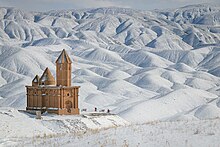Samson Makintsev
Samson Yakovlevich Makintsev Самсо́н Я́ковлевич Маки́нцев سامسونخان (Samson Khan) | |
|---|---|
| Born | 1780 Caucasian line Russian Empire |
| Died | 1849 or 1853[1] (aged 68-73) Persian Empire |
| Allegiance | |
| Years of service | 1802-1840 |
| Rank | |
| Commands held | Commander of Bogatyr battalionof Persian Imperial army |
| Battles/wars |
|
Samson Yakovlevich Makintsev (
Biography
From at least the 19th century, and probably earlier, a steady stream of deserters from the
One of the more notable deserters who enlisted in the Iranian service was Samson Yakovlevich Makintsev, a staff-trumpeter sergeant, who deserted from the
In Persia
Historian Stephanie Cronin states that the reason for his desertion is not definitely known, but the men of his regiment apparently believed that he had stolen the mouthpieces from the regiment's silver trumpets.
Through his efforts, which included the enlisting of other fugitives into the ranks, Makintsev earned promotion to the rank of
Makintsev quickly gained the complete confidence of Abbas Mirza, who gave the
At first Makintsev recruited amongst the Russians whom he found in Tabriz – deserters, prisoners of war, and even runaway peasants.[7] As Cronin notes, after his regiment suffered severe losses in the 1804–1813 Russo-Persian War, Makintsev started an active approach.[7] Not waiting for deserters to arrive in Tabriz of their own accord, he made every effort to encourage the flight of soldiers in the Russian army then occupying the Iranian territory that is modern-day Azerbaijan.[7] He employed a range of methods, including "enticements, money and cunning", and he organized schemes to encourage troops to desert their Russian units. Persuasion was tried first, and then Makintsev's men would ply the Russians "with wine and seize them".[7]
The reputation of Makintsev, now with the rank of general, as a trusted soldier of the crown prince and commander-in-chief,
The strength of the regiment fluctuated. In 1822 they were estimated to number 800–1,000 troops, but after the second Russo-Persian War (1826–1828) it was reported that there were as many as 3,000.[7] In 1833 alone, 400 new deserters arrived from Russia.[7] Compared to the native Nizam troops, this was a comparatively substantial number, which, though also fluctuating and uncertain, probably amounted to around 12,000 by the early 1830s, according to Cronin.[7] Some decided to settle permanently in Iran, integrating into local society, their habitual drunkenness apparently presenting no impediment to social acceptance.[8] Some yearned to return home,[9] but many married and established families. Makintsev himself married and had children, and those who married were given land and apparently lived well.[9] Makintsev inhabited a large house in the Tabriz arg (citadel), having made an extremely advantageous marriage to the daughter of the exiled Prince Alexander of Georgia who was living in Iran proper as well.[9]
Makintsev's regiment was the fighting core of the Nizam-i-Jadid, and appears to have possessed considerable combat power.

Russia had been making extensive efforts and appeasement policies for years towards the deserters to repatriate them, with, eventually, relatively high success.[10] Makintsev himself declined the offer, however, apparently out of fear that he would be treated differently from the other deserters, tried separately, and punished. He died in 1849 and was buried under the altar of an Orthodox church (Saint John Church of Sohrol) in Iranian Azerbaijan that he himself had rebuilt[10] in 1840.[11]
By the early 1850s the deserter regiment of which Makintsev had once been part had vanished, its remnants in Iran absorbed into the native Nizam units.[12]
Issue
Samson Khan married three times;[13]
1. an Armenian from the village Kizyldzha near Salmas of the Khoy Khanate. Samson killed her later for infidelity.
2. Yelizaveta – a daughter of
3. unknown – died childless.
Children;
From the first marriage, he had three daughters. From the second, he had a son, Jebrail, and a daughter, Anna. His son Jebrail later served as an aide-de-camp to Shah Naser al-Din, and was known by the name of Jebrail Khan.[14]
See also
- Russo-Persian War (1804-1813)
- Russo-Persian War (1826-1828)
References
- ^ Bazilenko, Igor V. Russian fugitive Samson Y. Makintsev (1780–1853) and his half-century service to Iran.
- ^ a b c d e f Cronin 2013, p. 148.
- (in Russian) edition; Русская старина. publisher; Тип. В. С. Балашева, 1876. Vol. 15 page 772
- ^ a b c d e f Cronin 2013, p. 153.
- ^ RGVIA, f. 489, op. 1, d. 2476, l. 1506-116.
- ^ Cronin 2013, pp. 148–149.
- ^ a b c d e f g h i j k l m n o p Cronin 2013, p. 149.
- ^ Cronin 2013, pp. 149–150.
- ^ a b c d e f g h i j Cronin 2013, p. 150.
- ^ a b Cronin 2013, p. 151.
- ^ "فصلنامه فرهنگی پیمان". paymanonline.com (in Persian).
- ^ Cronin 2013, p. 160.
- ISBN 5-7838-0437-1.)
{{cite book}}: CS1 maint: numeric names: authors list (link - ^ Lepyokhin 2000, p. 49.
Sources
- Cronin, Stephanie (2013). Iranian-Russian Encounters: Empires and Revolutions Since 1800. Routledge. ISBN 978-0415624336.
- Kibovskii, Aleksandr (1996). ""BAGADERAN" - RUSSIAN DESERTERS IN THE PERSIAN ARMY, 1802-1839". Tseikhgauz. Archived from the original on 2017-07-05.
- Lepyokhin, Mikhail (2000). Русский биографический словарь, т. 8 [Russian Biographical Dictionary, vol. 8] (in Russian). Moscow: Aspekt Press. ISBN 5-7567-0079-X.
- Берже А. П. Самсон-хан Макинцев и русские беглецы в Персии 1806-1853 гг. // Русская старина. – Т. 15, No. 4 (апрель). – С. 775. (in Russian)
